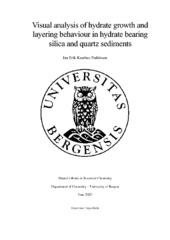| dc.contributor.author | Parkinson, Jan Erik Kaarhus | |
| dc.date.accessioned | 2020-08-06T04:28:01Z | |
| dc.date.available | 2020-08-06T04:28:01Z | |
| dc.date.issued | 2020-08-05 | |
| dc.date.submitted | 2020-08-04T22:00:05Z | |
| dc.identifier.uri | https://hdl.handle.net/1956/23482 | |
| dc.description.abstract | Gas hydrates are crystalline solids with cage-like structures of water containing a guest molecule. They have sparked great interest due to their potential as an energy source, and the possibility of utilizing them for carbon capture and storage. In the North Sea, natural gas hydrates are found dispersed in fine grained sediments. Most previous laboratory studies on hydrates in sediments have focused on formation in coarse-grained sediments and intrapore hydrate behaviour. More research is therefore required on hydrate formation behaviour fine-grained sediments. This thesis presents a study on macroscopic hydrate formation behaviour in colloidal silica and fine-grained quartz sediments. Tetrahydrofuran (THF) is used as hydrate former in place of methane, as it forms hydrates at atmospheric pressure. The formation of hydrates is recorded by a camera over a span of 24 to 48 hours, and colouring is used to enhance visibility. A range of experiments are set up to observe hydrate growth within varying environmental conditions, such as electrolyte content and porosity. Magnetic resonance imaging (MRI) is also used to observe hydrate formation behaviour from within samples. Hydrates were observed to form nodes, veins, channels and layers in colloidal silica and fine-grained quartz sediments. The formation behaviour was seen to depend on reaction kinetics. Slow hydrate formation saw the build-up of larger hydrate crystals, while fast hydrate growth saw a fine dispersion of hydrates with less tendency to displace sediments. Colloidal suspensions saw a more complete and dispersed hydrate growth, while larger but fewer hydrate structures were observed in the more dense sediments. Utsira formation water with an electrolyte content of roughly 3,2 weight percent was also seen to greatly enhance hydrate growth, despite its salt content. Due to the COVID-19 pandemic, planned experiments using Equinor’s MRI instrument had to be cancelled. Only a few images were therefore extracted. These images provide the methodology for the MRI experiments, and provide evidence that hydrate layering behaviour is also prevalent within the undisturbed sediments. | en_US |
| dc.language.iso | eng | |
| dc.publisher | The University of Bergen | en_US |
| dc.rights | Copyright the Author. All rights reserved | |
| dc.subject | magnetic resonance imaging | |
| dc.subject | gas hydrates | |
| dc.subject | tetrahydrofuran | |
| dc.subject | MRI | |
| dc.subject | hydrates | |
| dc.subject | clathrate hydrates | |
| dc.subject | THF | |
| dc.title | Visual analysis of hydrate growth and layering behaviour in hydrate bearing silica and quartz sediments | |
| dc.type | Master thesis | |
| dc.date.updated | 2020-08-04T22:00:05Z | |
| dc.rights.holder | Copyright the Author. All rights reserved | en_US |
| dc.description.degree | Masteroppgave i petroleumsteknologi | en_US |
| dc.description.localcode | PTEK399 | |
| dc.description.localcode | MAMN-PETR | |
| dc.subject.nus | 752223 | |
| fs.subjectcode | PTEK399 | |
| fs.unitcode | 12-24-0 | |
